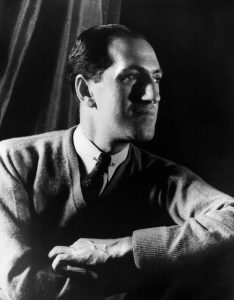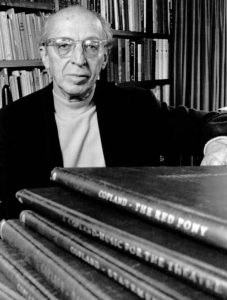7. The American Style

As we will see in a later chapter, jazz is a uniquely American style. American orchestral composers were becoming aware of jazz in the early 20th century, and George Gershwin (1898–1937) was no exception. Gershwin was a brilliant talent who dropped out of school at the age of fifteen to begin a professional career playing piano in New York’s “Tin Pan Alley.” After several years of success as a performer and composer, he was asked by the famous band leader Paul Whiteman to compose a work that would help raise people’s perceptions of jazz as an art form. The resulting work, Rhapsody in Blue, combines the American blues style with the European symphonic tradition into a brilliant composition for piano and orchestra.
In addition to Rhapsody in Blue, George Gershwin is also known for his opera Porgy and Bess. Although not a true opera in the strict sense of the term (Gershwin dubbed it a “folk opera”), the piece is considered one of the great American operatic works of the century. The story is set in a tenement in Charleston, South Carolina. Based on DuBose Heyward’s novel Porgy, the opera is sung by classically trained black singers to depict the tragic love story between the two main title characters. Gershwin based the music for the opera on elements of folk music, referring to southern black musical style such as the blues and spirituals. Drawing on the 19th-century opera tradition, Gershwin made use of leitmotifs to represent people or places. Near the beginning of the opera, we hear the famous aria “Summertime,” which depicts the hot, hazy atmosphere in which the story is set.

Like Gershwin, Aaron Copland (1900–1990) was instrumental in helping to define a distinct American sound by combining his European musical training with jazz and folk elements. As an early 20th-century composer, Copland was active during the Great Depression, writing music for the new genre of radio, the phonograph, and motion pictures. El Salon Mexico (1935), Fanfare for the Common Man (1942), and Appalachian Spring (1944) are three of Copland’s most famous works. He won a Pulitzer Prize for his music for the ballet Appalachian Spring and was also an Oscar-winning film composer. Appalachian Spring is a ballet depicting a pioneer wedding celebration in a newly-built farmhouse in Pennsylvania. It includes the now well-known Shaker song Simple Gifts (at 16:56 of the above linked video). Copland’s unique style evokes images of the landscape of the west, as we can hear in his score for the ballet Rodeo (1942).
Focus Composition: Fanfare for the Common Man by Aaron Copland
One of the ways in which Copeland was able to capture the sense of vastness of the American landscape was through his use of certain harmonic intervals (two notes played together) that sound “hollow” or “open.” These intervals—perfect 4ths and perfect 5ths—have been used since medieval times, and were named so due to their simple harmonic ratios. The result is music that sounds vast and expansive. Perhaps the best example of this technique is found in Copland’s famous Fanfare for the Common Man.
While fanfares are typically associated with heralding the arrival of royalty, Copland wanted to create a fanfare that celebrated the lives of everyday people during a trying time in American history. The piece was premiered by the Cincinnati Symphony Orchestra on March 12, 1943 at the height of World War II. To this day, no other piece stirs up patriotic emotions like Fanfare for the Common Man. It has been used in countless movies, television shows, and even military recruitment ads. The piece came to define Copland’s uniquely American compositional style and remains one of the most popular patriotic pieces in the American repertoire.
Listening Guide
“The President’s Own” United States Marine Band
Composer: Aaron Copland (1900–1990)
Composition: Fanfare for the Common Man
Date: 1942
Genre: fanfare; a short, ceremonial piece typically composed for brass and percussion
Performing Forces: brass and percussion
| Timing | Performing Forces, Melody, and Texture |
| 0:00 | Opening crash (tam-tam) heralds introduction by the bass drum and timpani that slowly dies down during the third statement. Slow and deliberate |
| 0:22 | Slow fanfare theme enters. The melody is comprised of many interval perfect 4ths and perfect 5ths, which convey a sense of openness, played by the unison trumpets. This music without harmonic accompaniment creates a sense of starkness. A fragment of the percussion introduction is then repeated. |
| 0:51 | French horns enter, moving a perfect 5th below the trumpets, with periodic hits from the percussion. |
| 1:24 | The percussion repeats the material from the introduction. |
| 1:35 | The low brass enters with the main theme, imitated by the timpani, horns, and trumpets. Full ensemble |
| 2:41 | Melodic motive is restated with rhythmic augmentation, ending the piece on a climactic and loud chord. |
